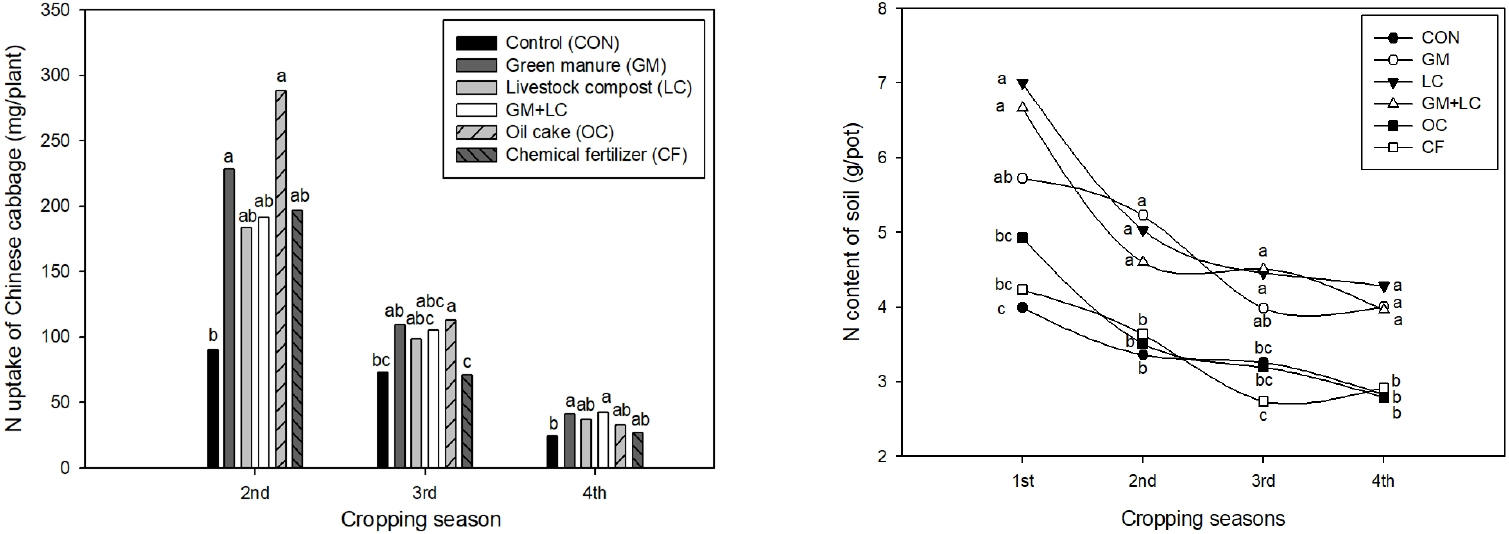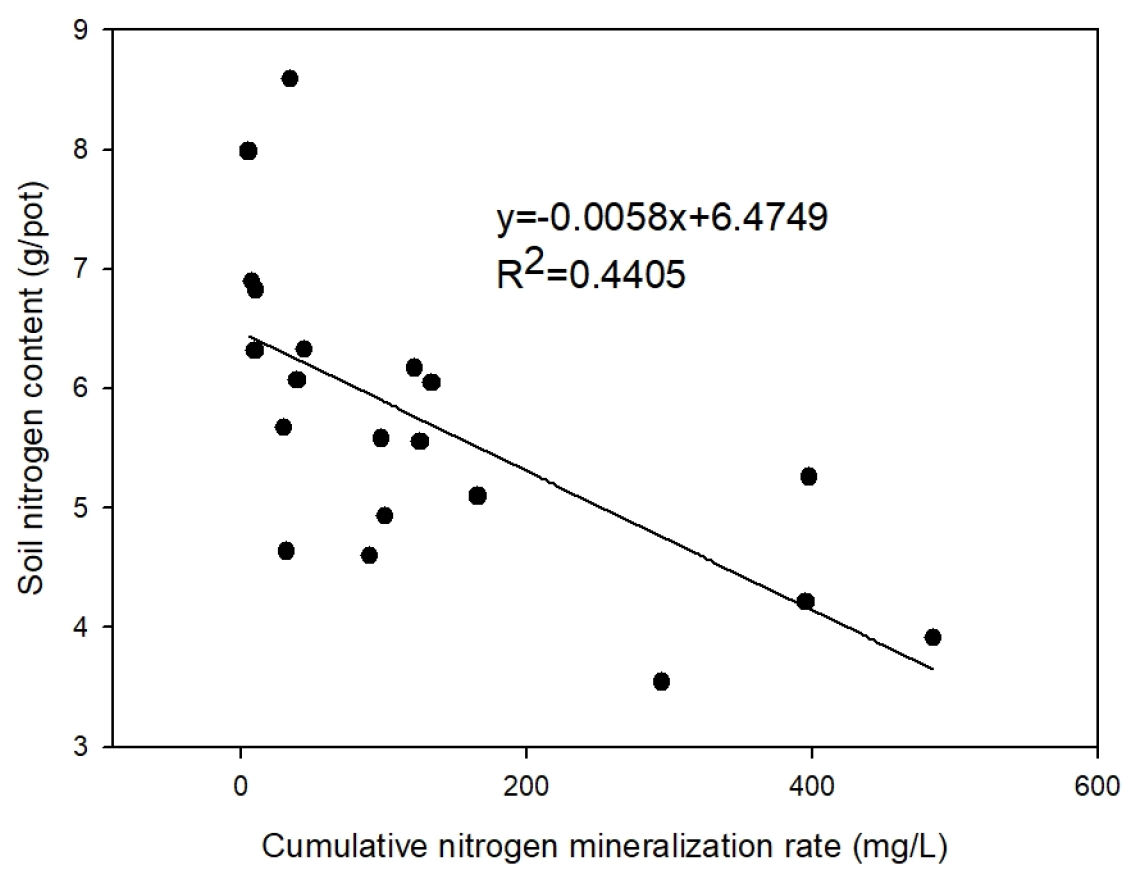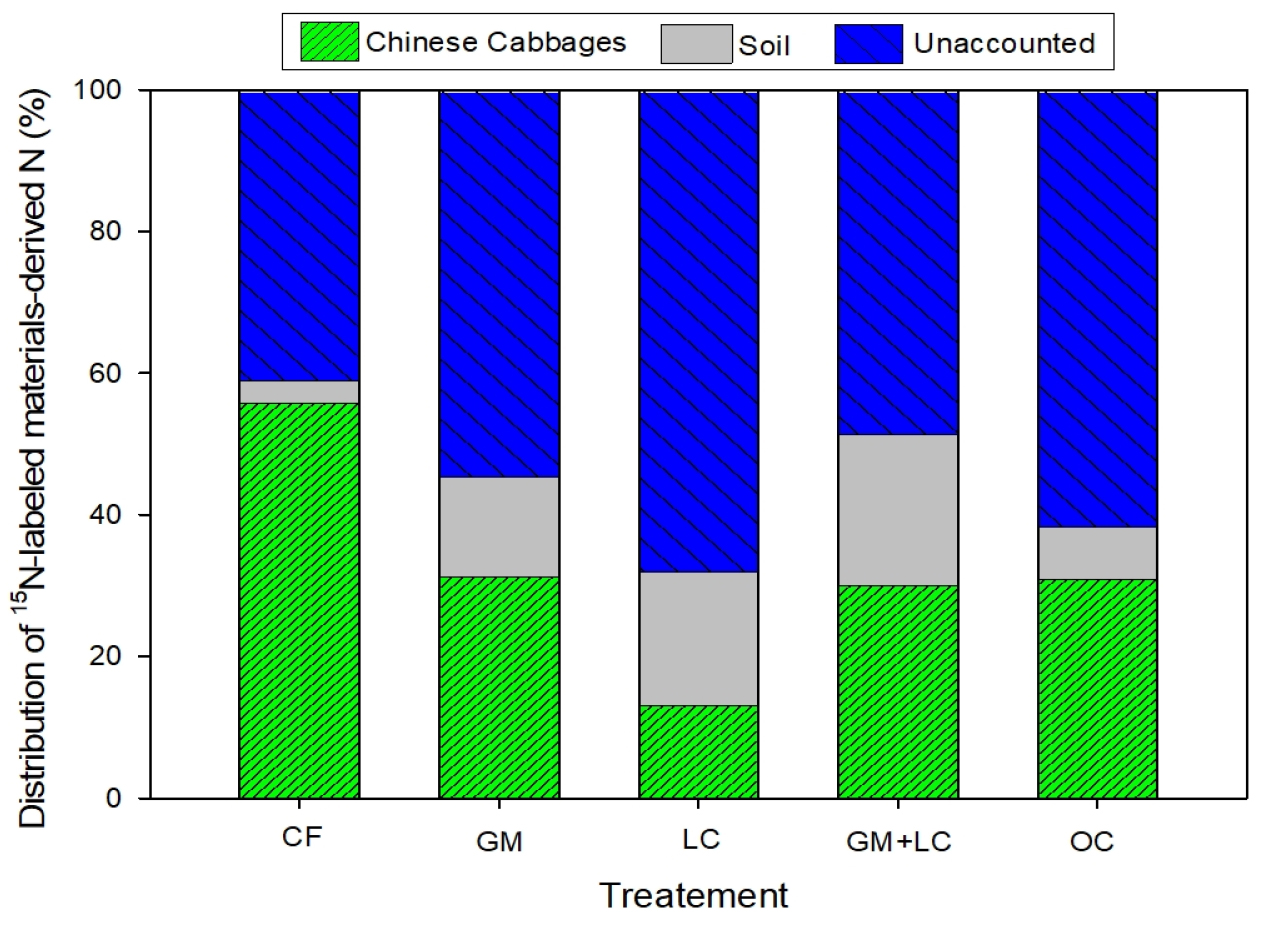Introduction
Materials and Methods
중질소 표지 유기자원 제조
토양 처리 및 배추 재배
토양 및 식물체 분석
통계 분석
Results and Discussion
유기자원 유래 질소의 잔존효과
질소 동태
Conclusions
Introduction
친환경농업에 대한 관심이 증가하면서 토양·양분관리도 다수확 중심에서 환경을 고려한 최적시비에 대한 관심이 증가하고 있다. 배추는 국내 주작물 중 하나로 2019년 기준 생산면적은 48,406 ha (KOSIS, 2020)로 전체 엽채류 재배면적 중 52%를 차지하고 있다. 노지 배추의 경우 질소의 표준시비량이 320 kg/ha (NAIS, 2019)로 잎을 주로 이용하는 배추는 식량작물이나 다른 원예작물보다 재배 중에 질소를 많이 시비 (Lee et al., 2016)하는 다비성 작물 중 하나이다. 특히 질소의 경우 농경지에 투입된 후 대기로 탈질, 휘산 등으로 유실되어 기후변화나 미세먼지를 유발 (Lee et al., 2017; Kim et al., 2017)하거나 수계로 용탈, 유거되어 부영양화를 유발 (Lee et al., 2012; Erisman et al., 2013; Lim et al., 2014; Valkama et al., 2015; Poffenbarger et al., 2018)하는 등 환경에 영향을 줄 우려가 크기 때문에 적절한 관리가 필요하다.
작물에 질소를 공급하기 위해 사용하는 것은 크게 유안, 요소와 같은 무기질비료 (화학비료)와 퇴비, 유박 등의 유기자원으로 만든 유기질비료 두 가지가 있다. 유안과 같은 무기질비료는 물에 바로 녹아 토양 수용액에서 암모늄이온으로 작물 뿌리로 바로 이용되며 작물이용률이 50 - 80%수준으로 높다 (Gutser et al., 2005). 하지만 유기자원에 포함된 유기태질소는 미생물에 의한 분해과정을 거쳐 무기태질소로 무기화되고 난 뒤 작물에 이용되게 때문에 (Janssen, 1996), 질소 공급은 상당한 시간이 걸리고 (Rahman et al., 2001), 질소이용률도 0 - 50% 정도로 낮다 (Gutser et al., 2005). 이러한 유기자원의 질소 공급은 자재의 품질 (C/N률, 리그닌 및 폴리페놀 함량 등), 환경조건 (온도, 수분 등), 미생물 등에 영향을 받는다 (Mafongoya et al., 1998; Kumar and Goh, 2003; Khalil et al., 2005). 또한, 작물에 이용되는 양이 적은 유기태질소는 투입된 질소의40 - 80% 이상이 토양 유기물로 남아 (Mafongoya et al., 1998) 후작물의 생육 및 양분이용률에 잔존효과 (residual effect)를 보이기도 한다 (Babu et al., 2013; Singh et al., 2018). 그렇기 때문에 작물의 안정 생산과 환경에 미치는 영향을 최소화하기 위한 적정 유기자원 사용량 산정시 토양에 잔존하는 양분 상태를 고려할 필요가 있다.
계분, 지렁이분변퇴비, 볏짚 등 유기자원의 잔존효과를 겨자, 유채, 옥수수, 양파 등 다양한 작물을 대상으로 연구 (Bejbaruha et al., 2009; Singh et al., 2018; Nurhidayati et al., 2018; Yoldas et al., 2019)한 바 있다. 또한 장기간 퇴비 연용은 작물 생산량과 토양에 수년간 잔존효과가 있다고 보고 (Eghball, 2002; Ginting et al., 2003; Leroy et al., 2007; Sodhi et al., 2009)된 바 있다. 이러한 잔존 유기자원에 의한 질소이용율은 작물의 특성과 재배기간, 토양 비옥도 등의 환경조건에 영향을 받는다 (Lanna et al., 2018). 특히 작물 재배 후 토양에 잔존하여 후작물에 영향을 미치기 때문에 해외에서는 이를 활용할 방안을 모색하고 있으나, 국내에서는 이러한 연구가 거의 수행되지 않고 있다.
토양에 잔존하는 질소를 정량하는 방법으로 안정동위원소를 활용할 수 있다 (Holbeck et al., 2013). 본 연구는 지속적인 작물재배에 따른 유기자원과 화학비료의 질소 잔존효과를 평가하고자 작물의 질소흡수 및 토양 잔존량의 변화를 조사하였다. 또한 15N을 이용하여 질소 동태를 분석하여 유기자원을 연용하는 농경지에서 시비량 조절을 위한 기초자료로 활용하기 위해 연구를 수행하였다.
Materials and Methods
중질소 표지 유기자원 제조
Seo et al. (2008) 및 Lee (2013)를 참고하여 중질소를 인위적으로 표지 (labeling)한 풋거름작물 (헤어리베치, 호밀), 가축분퇴비, 유박 (대두박)을 제조하였다. 자세한 제조방법은 Lee et al. (2020)과 같다. 처리구는 풋거름 작물 (GM), 가축분퇴비 (LC), 풋거름작물+가축분퇴비 혼용 (GM+LC), 유박 (OC), 화학비료 (CF), 무처리 (CON) 총 6처리 4반복으로 구성하였다. 처리구별 투입된 자재의 총질소 및 atom % 15N 함량은 Table 1과 같다.
Table 1.
Chemical components of 15N-labelled materials used at the experiment.
| Treatment | atom % 15N | T-N (%) | C/N ratio |
| Green manure (GM) | 5.00 | 3.5 | 11.2 |
| Livestock compost (LC) | 2.10 | 2.8 | 13.5 |
| GM+LC | 1.05 | 2.6 | 14.3 |
| Oil cake (OC) | 1.63 | 6.6 | 7.4 |
| Chemical fertilizer (CF) | 10 | 21 | - |
토양 처리 및 배추 재배
시험에 사용한 토양은 pH와 유기물함량, 치환성 칼륨과 칼슘이 적정범위보다 다소 낮았다 (Table 2). 공시작물은 대표적인 다비성 원예작물인 배추를 선정하였다. 이에 자재를 1회 시용 후 배추를 연작할 경우 토양 양분의 고갈 우려가 있어 매 작기 시작 전 무처리를 포함한 전체 포트에 질소를 제외한 동일량의 P, K, Ca, Mg을 보충한 후 배추를 재배하였다. ’18.9.10.에 1/2000a와그너포트 (토양 11 kg)에 토양검정 질소시비량의 130%인 456 kg N/ha에 해당하는 자재를 1회 처리 후 배추를 2018년 9월부터 2020년 5월까지 총 4작기 (Table 3) 동안 재배하였으며 1작기 이후 별도로 자재를 처리하지 않고 2 - 4작기 동안에 미치는 잔존효과를 분석하였다. 배추 품종은 가을작기는 CR추월, 봄작기는 내추대성 품종인 춘광을 사용하였다. 포트별 물관리는 계절별, 처리별로 배추 생육이 달라 배추 생육을 고려하여 상이하게 투입하였다.
Table 2.
Physico-chemical properties of the soil used at the experiment.
| Soil texture | pH |
T-N (g/kg) |
OM* (g/kg) | C/N |
Avail. P2O5 (mg/kg) | Exchangeable cation (cmol+/kg) | ||
| K+ | Ca2+ | Mg2+ | ||||||
| SL | 5.7 | 0.4 | 15 | 23 | 450 | 0.47 | 3.61 | 1.81 |
Table 3.
Date of organic materials application and crop transplanting (1 - 4 cropping season).
| Application | 1st | 2nd | 3rd | 4th | |
| date |
10. Sep. 2018, |
13. Sep. 2018 (96 days) |
8.April.2019 (88 days) |
25.Sep.2019 (71 days) |
18.March.2020 (71 days) |
토양 및 식물체 분석
토양에 자재 처리 후 무기태질소함량의 변화를 조사하기 위해, 일정 주기로 채취한 토양을 습윤상태로 2 mm체로 친 후 2M KCl로 침출한 다음 흐름주입분석기 (Lachat, QC8500, USA)를 이용하여 암모늄태 및 질산태질소 함량의 변화를 분석하였다. 배추는 작기별로 수확기에 생체량을 조사하였으며, 배추 및 토양내 질소 및 중질소 함량을 분석하기 위해 건조 및 분쇄 (Lee et al., 2020)한 시료를 원소분석기 (Elementar, vario Max CN element analyzer, Germany)와 질량분석기 (Elementar, Isoprime IRMS, Germany)를 이용하여 총 질소 및 질소 동위원소비 (14N/15N)인 δ15N를 분석하여 시료내 중질소 함량을 계산하였다 (Eq. 1).
수확기 배추회수율 (15Ncrop recovery) 과 1 - 4작기 배추 수확 후 토양잔존율 (15Nsoil recovery)은 (Eq. 2)과 같이 계산하였다 (Smith and Chalk, 2018).
Nsample은 시료 (배추 또는 토양)의 총 질소함량이며 a는 15N표지원이 투입된 시료의 atom % 15N, b는 무처리 시료의 atom% 15N를 나타내며, Nfertilizer는 15N표지원의 질소함량이며, c는 15N 표지원의 atom % 15N, d는 대기의 atom % 15N (0.3663%)이다.
1작기에 투입한 15N이 작기별 배추에 흡수 및 토양에 잔존한 비율인 총15N회수율 (15Ntotal recovery, %)은 배추회수율과 토양잔존율을 합하여 계산하였다. 유기자원으로 투입된 15N 중 배추와 토양에서 회수되지 않은 양 (Unaccounted 15N, %)은 환경으로 유실된 것으로 추정하였으며, 100 - 15Ntotal recovery으로 계산하였다.
통계 분석
자료의 통계분석은 SPSS를 이용한 분산분석으로 수행하였고, 95% 수준에서 Tuckey Test로 유의성 정도를 분석하였다.
Results and Discussion
유기자원 유래 질소의 잔존효과
자재 처리 직후 1작기에 수확한 배추의 생체량 및 질소흡수량은 Fig. 1과 같다. 유기자원 처리는 배추 생체량, 질소흡수량에 유의한 영향을 주었다 (p < 0.05). 유기자원 4종과 CF 모두 무처리보다 배추 생체량이 유의하게 높았으며, GM이 190% 수준으로 가장 높았고 LC가 155% 수준으로 가장 낮았다. 질소 흡수량 역시 무처리보다 유기자원 및 CF에서 유의하게 높았다. CF는 무처리 대비 589%로 처리 중 가장 높았으며, 유기자원 처리는 198 - 262%로 자재 종류간 유의한 차이는 없었다. 즉 동일 N량 시용시 자재 종류별로 배추 생체량 및 질소흡수량에 미치는 영향이 상이하였으며, LC를 제외한 유기자원 3종은 배추 생체량이 CF와 비슷하거나 높은 수준이었다. 반면 질소흡수량은 CF대비 1/2수준으로, CF보다 유기자원은 토양에서 분해되어 질소를 공급하는 속도가 느려 (Mafongoya et al., 1998; Boyhan and Hill, 2008; Yagioka et al., 2014) 초기 3개월동안 배추에 질소공급량이 적었기 때문으로 판단된다. 실제로 LC는 재배기간 중 질소순무기화가 거의 발생하지 않았는데 (Lee et al., 2020), 이 같은 특성 때문에 배추 수량과 질소흡수량도 처리 중 가장 낮은 것으로 판단된다.

Fig. 1
Fresh weight and N uptake of Chinese cabbages at the first harvesting stage in soil applied with fertilization (n=4). Values followed by the same lowercase letter were not significantly different based on Tuckey significant difference (a=0.05). CON is control (non-application); GM is mixture of hairy vetch and rye; LC is livestock compost; GM+LC is mixture of GM and LC; OC is oil cake of soybean; CF is chemical fertilizer (ammonium sulfate) at the rate of 456 kg N/ha.
처리한 자재의 잔존효과가 나타나는 2 - 4작기의 배추 생체량 및 질소흡수량은 Fig. 2와 같다. 1작기 배추를 수확한 후 토양에 남은 자재는 2 - 4작기에 재배한 배추 생체량과 질소흡수량에도 유의한 영향을 주었다 (p < 0.05). 배추 생체량은 2작기까지는 유기자재 4종과 CF 모두 무처리보다 유의하게 높았으나, 3작기부터는 유기자재만 유의하게 높은 경향을 보였다 (4작기 OC 제외). 즉, 유기자원은 종류별로 상이하였으나 화학비료보다 배추 생체량에 미치는 잔존효과가 더 오래 나타났다. 배추 질소흡수량도 생체량과 유사한 결과로 무처리 대비 2작기는 유기자재 4종과 CF 모두 2배이상 높았으나 LC, GM+LC, CF는 통계적으로 유의한 차이는 없었다. CF는 3작기 이후부터는 CON과 차이가 없어 잔존효과가 없었다. 유기자원은 3 - 4작기까지도 질소흡수량이 무처리대비 135 - 172% 수준으로 잔존효과가 다소 있는 것으로 보였으나 통계적인 유의성은 없었다. 이는 4작기로 갈수록 토양 질소 고갈에 의해 질소 흡수량이 1작기의 16%, 9%, 3% 수준으로 급격히 감소함에 따라 처리별 변이가 커져 유의한 차이를 볼 수 없었던 것으로 보인다. Yun et al. (2009)과 Lanna et al. (2018)은 비옥도가 낮을 경우 초기 토양에 양분이 부족하여 자재로 투입된 질소가 작물, 잡초 등에 다량 이용되고 용탈로 유실되어 처리에 의한 잔존효과가 거의 없었다고 하였다. 하지만, 본 실험에서는 토양의 유기물함량이 15 g/kg로 비옥도가 다소 낮았음에도 잔존효과가 있었으며 화학비료와 유기자재간 차이가 있었는데 이는 본 연구가 포트실험으로 수행되어 N시비량의 130%를 투입하였고, 잡초나 용탈 등으로 질소가 제거되는 양이 거의 없었기 때문으로 판단된다. 따라서 1작기에는 CF가 유기자원보다 2배이상의 N흡수량을 보였으나, 잔존효과가 나타나는 2작기부터는 유기자원의 N흡수량이 더 크게 나타나 배추에 미치는 잔존효과가 CF보다 더 큼을 알 수 있었다.
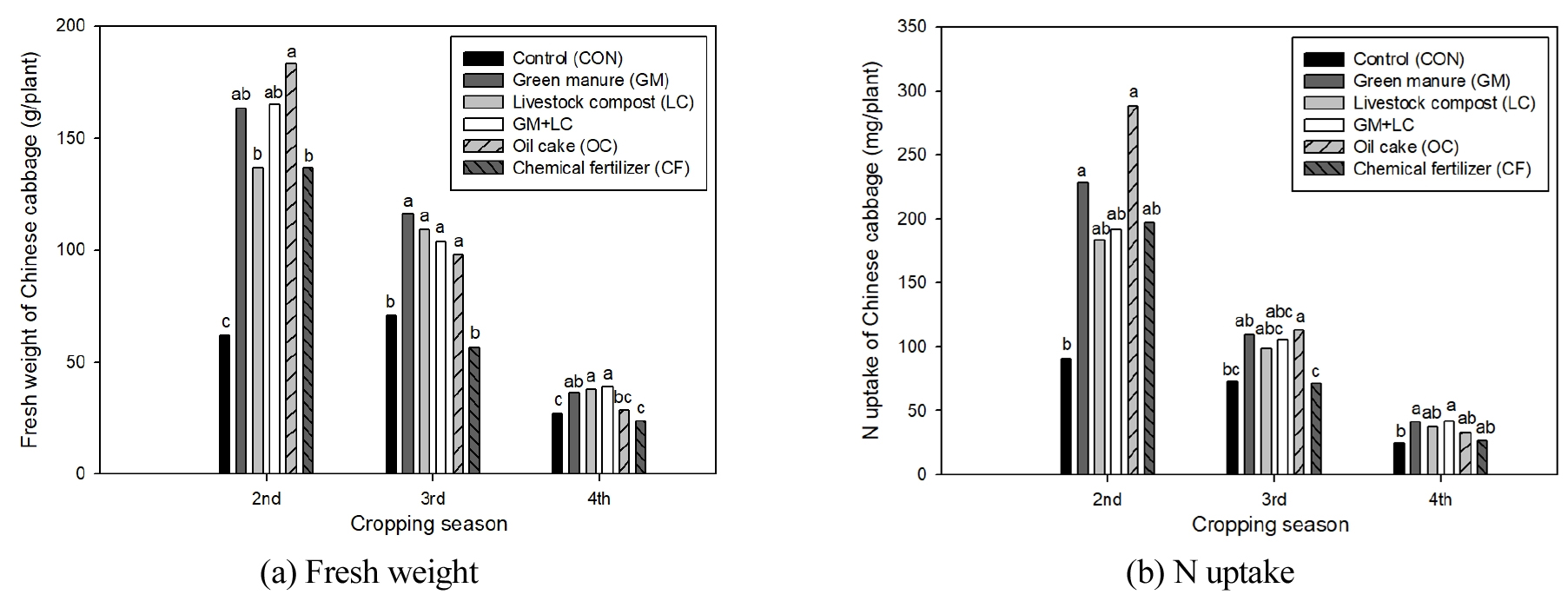
Fig. 2
Fresh weight and N uptake of Chinese cabbages at harvesting stage during continuous cultivation (2 - 4 cropping seasons) with fertilization (n=4). Values for the same cropping season followed by the same lowercase letter were not significantly different based on Tuckey significant difference (a=0.05). CON is control (non-application); GM is mixture of hairy vetch and rye; LC is livestock compost; GM+LC is mixture of GM and LC; OC is oil cake of soybean; CF is chemical fertilizer (ammonium sulfate) at the rate of 456 kg N/ha.
자재 처리 후 4작기 동안 토양의 질소 함량은 Fig. 3과 같다. 자재 처리는 배추 수확 후 토양 질소 함량에 유의한 영향을 주었으며 (p < 0.05), 1 - 4작기 모두 GM, LC, GM+LC는 무처리보다 유의하게 높았으며 (3작기 GM제외), OC와 CF는 4작기 동안 무처리와 유의한 차이가 없었다. 토양에 투입한 질소 중 배추에 이용되고, 환경으로 유실되고 남은 질소는 토양에 잔존하게 된다. 1작기에 배추 질소 흡수량이 가장 많았던 CF는 토양 잔존량도 가장 적었다. 유기자원 4종별 배추의 질소 흡수량은 유의한 차이가 없었으나, 토양 질소 잔존량은 LC, GM+LC가 OC에 비해 유의하게 높았는데, 이는 자재별 무기화특성과 관련이 있는 것으로 판단된다. 미생물에 의해 유기자재가 분해되는 속도가 빠르면 초기에 작물에 흡수되거나 환경으로 유실되는 질소량이 많아져 토양에 잔존하는 양이 적어지게 된다. 반대로 무기화가 늦게 진행되면 토양에 잔존량이 많다 (Babu et al., 2013)고 하였는데, 실제 자재별 무기화 특성을 분석한 결과 (Lee et al., 2020), 이와 유사하게 CF > GM > OC > GM+LC > LC 순으로 무기화량이 많았다. 또한, 1작기 배추 재배기간동안 누적 질소무기화량과 배추 수확 후 토양 잔존 질소함량간에는 부의 상관관계 (R2=44)가 있어 자재의 무기화특성이 잔존효과에 영향을 줄 수 있음을 알 수 있었다 (Fig. 4).
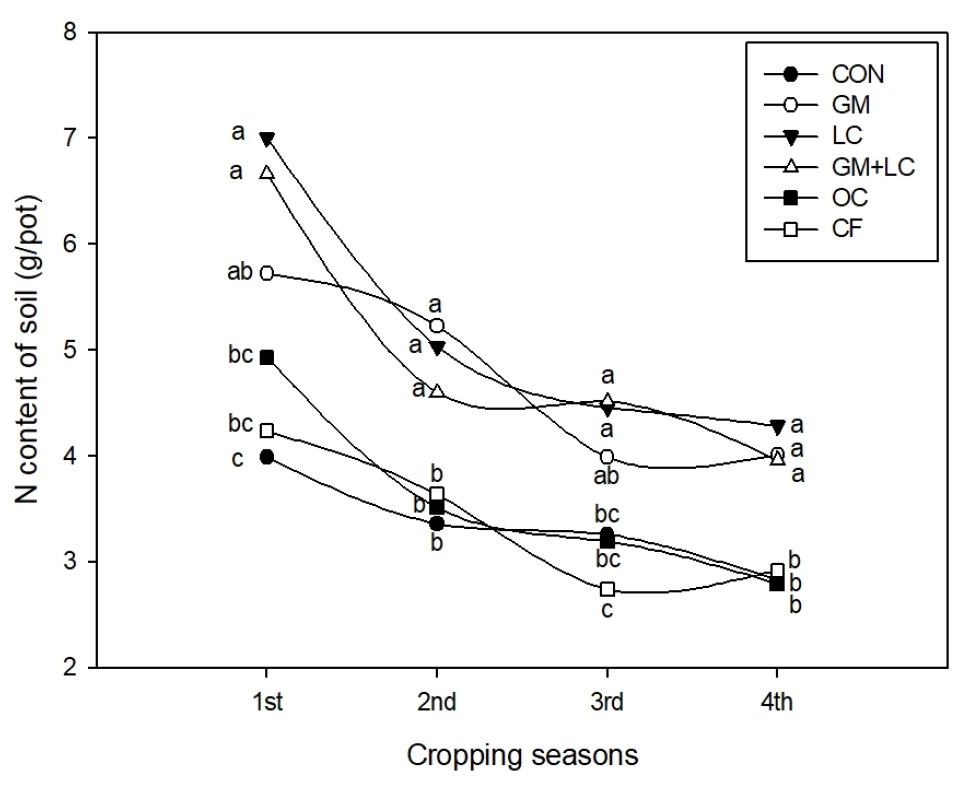
Fig. 3
Changes of soil N content at harvesting stage during continuous cultivation with fertilization (n=4). Values for the same cropping season followed by the same lowercase letter were not significantly different based on Tuckey significant difference (a=0.05). CON is control (non-application); GM is mixture of hairy vetch and rye; LC is livestock compost; GM+LC is mixture of GM and LC; OC is oil cake of soybean; CF is chemical fertilizer (ammonium sulfate) at the rate of 456 kg N/ha.
질소 동태
처리별 1회 시비된 15N이 4작기 동안 배추로 회수된 비율은 Table 4와 같다. 1작기의 배추회수율은 평균 28.2%였으며 처리별로 상이하였다. 이후 2작기 배추회수율은 평균 2.9%로 1작기의 약 1/10수준이었으며 이후 1%이하로 급격히 감소하였다. 1작기 회수율은 CF에서 53.5%로 가장 높아 자재로 투입한 질소가 가장 많이 이용되었으며, LC은 8.9%로 가장 낮았고, 나머지 유기자원은 CF의 1/2 수준인 25.3 - 27.3%만 이용되는 것으로 나타났다. 2작기 회수율은 5개 처리 모두 통계적으로 유의한 차이를 보이지 않았으며, 3 - 4작기 회수율은 통계적으로 유의한 차이를 보였으나 그 값이 1%미만으로 회수율이 매우 낮았다. 즉, 2작기 이후 유기자원으로 1회 투입된 질소가 배추에 이용되는 비율은 4%미만으로 미미한 수준으로 나타났다. 하지만 유기자원의 경우 1회성으로 시용하지 않고 지속적으로 시용하기 때문에 연용된 유기물을 고려할 때 그 경향이 달라질 것으로 보인다.
Table 4.
15N recovery (%) of Chinese cabbages at harvesting stage during continuous cultivation with fertilization (n=4).
| Treatment | 1st | 2nd | 3rd | 4th |
| CF | 53.5a | 1.9ns | 0.3c | 0.1b |
| GM | 27.3b | 2.8 | 0.9b | 0.3a |
| LC | 8.9c | 2.7 | 1.1ab | 0.3a |
| GM+LC | 25.3b | 3.1 | 1.3a | 0.3a |
| OC | 25.9b | 3.8 | 1.0ab | 0.2ab |
| Mean | 28.2A | 2.9B | 0.9B | 0.2B |
Values for each column followed by the same lowercase letter and for mean row followed by the same uppercase letter were not significantly different based on Tuckey significant difference (a=0.05). GM is mixture of hairy vetch and rye; LC is livestock compost; GM+LC is mixture of GM and LC; OC is oil cake of soybean; CF is chemical fertilizer (ammonium sulfate) at the rate of 456 kg N/ha.
처리별 토양 내 중질소 잔존율은 Table 5와 같다. 1작기 배추 수확 후 토양잔존율은 평균 31%였으며 처리별로 상이하였다. 이후 토양잔존율은 점진적으로 감소하여 4작기 배추를 수확 한 후 1작기의 약 1/2수준인 13%로 감소하였다. 1작기 토양잔존율은 LC, GM+LC에서 48.5 - 49.6%로 높고, CF은 6.1%로 가장 낮았는데 유기자원으로 투입된 질소가 작물에 흡수되기 보다는 토양에 많이 남아있음을 알 수 있었다. 2작기 잔존율은 4개 유기자원 처리구는 통계적으로 유의한 차이를 보이지 않았으며, CF는 5.2%로 낮았다. 4작기 토양잔존율은 LC 및 GM+LC에서 유의하게 높고, CF 및 OC에서 유의하게 낮았다. 2 - 4작기 토양잔존율은 CF보다 유기자원이 2 - 7배 높아 토양에 잔존한 N가 많으나, 이것이 배추에 이용되는 비율은 크지 않은 것으로 나타났다. 이는 토양에 남은 유기자원의 경우 초기에 이분해성 유기물은 빠르게 분해되고 리그닌과 같은 난분해성이 주로 남아 (Juan et al., 2018) 이후에도 작물에 많이 이용되지 못하기 때문으로 보인다.
Table 5.
15N recovery (%) of soil at harvesting stage during continuous cultivation with fertilization (n=4).
| Treatment | 1st | 2nd | 3rd | 4th |
| CF | 6.1c | 5.2c | 2.9d | 3.3c |
| GM | 27.7b | 23.7ab | 13.7b | 14.1b |
| LC | 48.5a | 33.3a | 21.9a | 18.9a |
| GM+LC | 49.6a | 27.8ab | 22.2a | 21.3a |
| OC | 23.0bc | 20.0b | 10.9c | 7.5c |
| Mean | 31.0A | 22.0AB | 14.3B | 13.0B |
15N 잔존율을 이용해 토양에 투입한 유기자원에서 유래한 N의 동태를 추적한 결과는 Fig. 5과 같다. 자재를 1회 투입 후 배추를 총 4회 재배한 결과 4작기까지 총 배추회수율은 CF가 55.8% 가장 높고, GM, GM+LC, OC는 약 30%, LC는 13.1%로 가장 낮았다. 4작기 토양잔존율은 CF는 3.3%로 토양에 거의 잔존하지 않았으며, 유기자원은 이보다 2 - 7배 높은 것으로 나타났다. 유기자원 중 무기화량이 많았던 OC는 CF와 유의한 차이를 보이지 않았다. 투입한 질소 중 배추와 토양에 회수되지 않은 질소는 환경으로 유실된 것으로 간주하였는데, CF가 41%로 가장 낮고 작물에 회수되는 비율이 적었던 유기자원은 48.6 - 68%가 유실되는 것으로 나타났다.
Conclusions
토양내 시용한 유기물은 화학비료에 비해 천천히, 장기간에 걸쳐 분해되어 단기간에 이용되는 양은 적지만 장기적인 토양 비옥도 관점에서 유리할 것이라고 인식되어왔다. 이에 실제 유기자원 4종과 화학비료를 1회 투입 후 4작기 동안 배추를 재배하여 배추와 토양에 미치는 잔존효과를 조사한 결과, 1작기에는 투입한 자재에 의한 질소 효과가 뚜렷하게 나타나, CF가 유기자원보다 2배이상 높은 질소흡수량을 보였다. 반면 잔존효과가 나타나는 2작기 이후부터는 자재별로 배추에 흡수되는 질소량이 1작기의 16% 이하로 급격하게 감소하였으며, CF 대비 유기자원에서 배추 생체량 및 질소흡수량, 토양에 미치는 잔존효과가 유의하게 크게 나타났다. 또한 이러한 자재별 잔존효과의 차이는 4작기동안 질소동태에도 영향을 주어, CF는 작물에 이용되는 양이 많은 반면 유기자원은 토양에 잔존하는 양이 많아 질소의 작물-토양-환경 동태가 각각 다르게 나타났다. 비록 본 연구에서는 유기자원을 1회 시용하여 잔존효과가 있었으나 그 효과가 크지 않았지만, 일반적으로 유기자원은 지속적으로 시용되기 때문에 누적된 유기자원을 고려한다면 잔존효과가 더 클 것으로 판단된다. 이에 주로 유기자원으로 토양·양분관리를 하는 경우 토양에 남아있는 양분의 잔존효과를 충분히 고려하여 시비량을 산정해야 할 것으로 판단된다.



